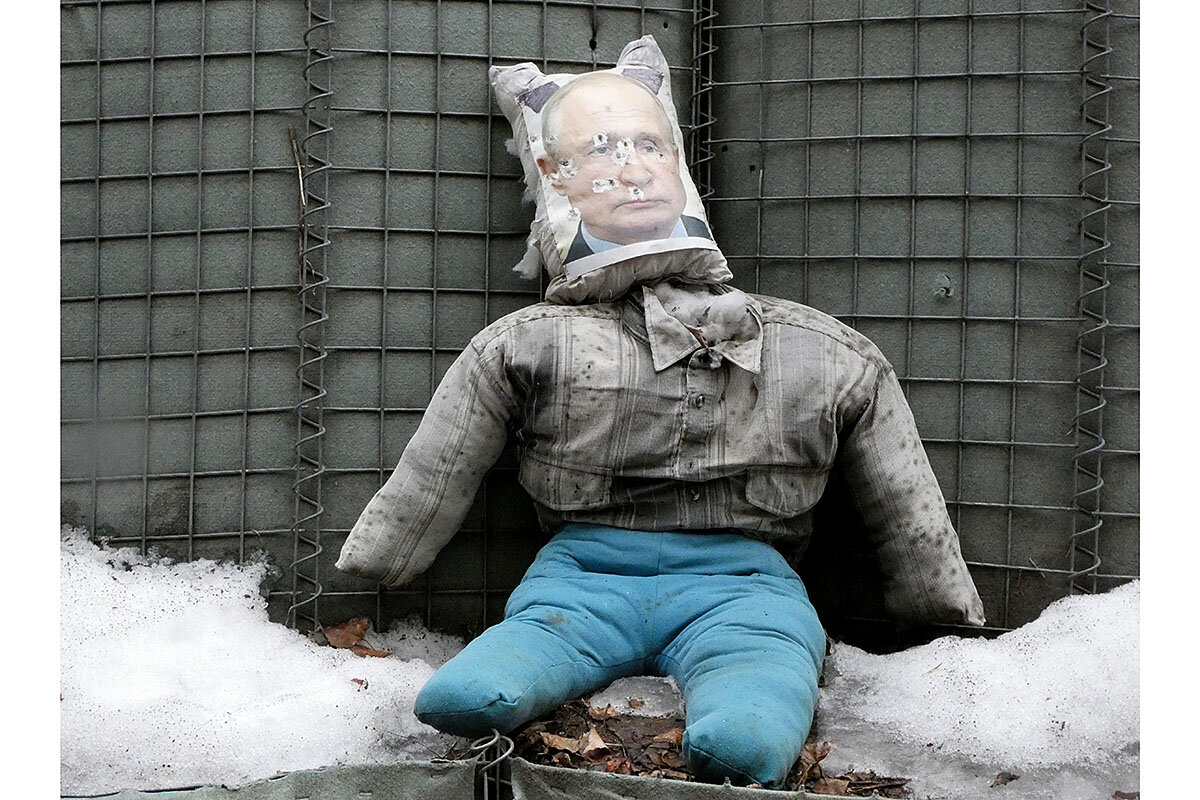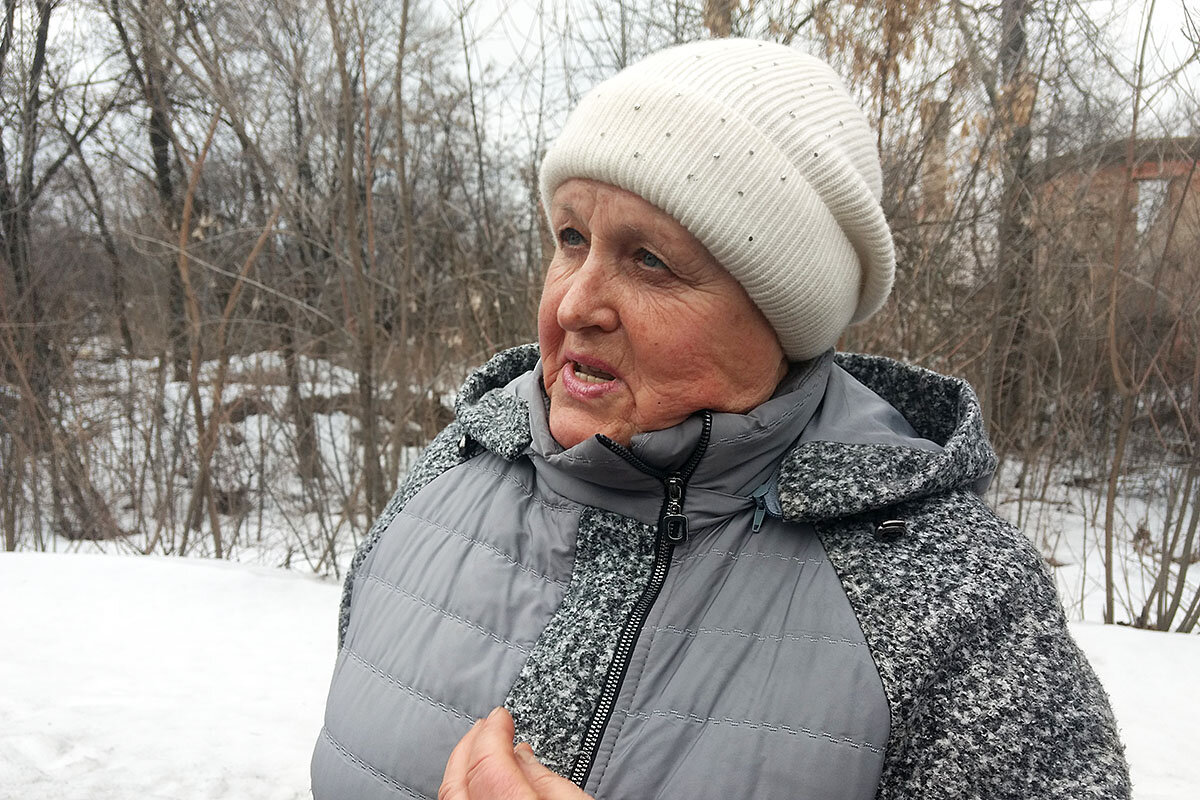For Ukrainians on the front line, Russian threat is just part of life
Loading...
| Zolote, Ukraine
Andrei Vitaliovych peers through a handheld periscope over the top of a trench wall at a line of barren trees some 350 yards away. The junior sergeant with the Ukrainian army explains that the trees mark the front-line position of Russian-backed separatist fighters near this mining town of 13,000 residents in southeastern Ukraine.
“When the wind is right, you hear them talking,” he says, stepping down into the trench and sinking ankle-deep into mud as thick as clay. “They probably hear us sometimes.”
On Thursday, the enemy was more audible – and more menacing. Artillery and mortar rounds fired from rebel-occupied territory thudded into the wet earth a half-mile from the trenches patrolled by Sergeant Vitaliovych’s unit with the 24th Mechanized Brigade.
Why We Wrote This
Much of the West is on tenterhooks about a Russian invasion of Ukraine. But at the front lines, where Ukrainian troops face Russia-backed separatists, it all feels like part of the routine.
The shelling occurred as tensions spiked between Ukrainian and separatist forces in the southern portions of the Luhansk and Donetsk regions along the Russian border that rebels have held since 2014.
The Ukrainian military has reported more than 50 attacks on its front-line positions over the past 48 hours. In Stanytsia Luhanska, east of Zolote, a rocket struck a kindergarten and wounded three people Thursday. Separatist leaders claimed government forces fired mortars and grenades into occupied areas in multiple incidents during the same period, and earlier Friday announced a large-scale evacuation of residents.
Ukrainian President Volodymyr Zelenskyy called the kindergarten shelling a “big provocation” as U.S. President Joe Biden warned that the threat of a Russian invasion of its neighbor remained “very high.” Mr. Zelenskyy attended a security conference Friday in Munich to meet with German Chancellor Olaf Scholz, U.S. Vice President Kamala Harris, and other world leaders. Mr. Biden was scheduled to talk with NATO allies as they seek a diplomatic resolution to the crisis.
The Organization for Security and Cooperation in Europe reported Friday that Russia has deployed up to 190,000 troops along Ukraine’s border. In the shadow of that buildup, and in contrast to rising fears in the West of Russia’s intentions, a sense of calm prevailed this week among soldiers and villagers in Zolote and elsewhere near the front lines.
“We have been in this situation now for eight years, so we are used to it,” says Sergeant Vitaliovych, who enlisted when war erupted in Luhansk and Donetsk, an industrial region of the country known as Donbass. He speaks with casual affability amid the occasional boom of incoming artillery, swinging the pipe periscope at his side as if strolling with an umbrella in his hometown village outside the western city of Lviv.
“The talk of invasion – it doesn’t affect us,” says Sergeant Vitaliovych, the father of a 3-year-old daughter with his wife, a fellow soldier. “We will be ready, the same as always.”
“We have to go on living”
Dozens of homes and businesses in Zolote bear the scars of war – rooftops blown open by artillery, walls pockmarked by bullets and shrapnel – and separatists retain control of one section of the village.
Yet for Anhelina Polishchuk, an area native and a grandmother, neither the sound of rocket fire nor the exchange of accusations between Ukrainian and Russian officials provokes cause for concern.
“I’m not worried,” she says, pausing on her walk home from a nearby market. She wears a stylish zip-up coat to keep out the cold, and the flower design on her tote bag lends a dash of springtime brightness to winter’s gray-white tableau. “You hear some shooting or some rockets, but you can’t let that scare you. We have to go on living.”
In Niu-York, a village in Donetsk some 50 miles south of Zolote, residents and troops offer a similar perspective. Olha Mykolaivna, a mother of two young sons, ascribes the lack of public panic to the steady presence and improved capability of Ukraine’s military.
“I believe that our soldiers can protect us,” she says, speaking in Russian, the predominant language of Donbass. She and her husband stopped by a bakery to pick up pastries and bread on their way home to dinner. Each wears a face mask adorned with a small Ukrainian flag.
“The Russian government wants us to be afraid,” she says. “But we can see what they are doing. It is nothing new.”
The war in Luhansk and Donetsk has displaced an estimated 1.5 million people. The army has converted abandoned houses into outposts in Niu-York and across the front line, and its enormous troop carriers now rumble along the town’s narrow dirt roads with the same regularity as municipal buses.
Most of the soldiers with the 46th Air Assault Brigade deployed to the area live beneath the ground’s surface in trenches that form a subterranean maze in and around the village. They profess to worry more about the cold than an invasion.
“I really don’t think anything big is going to happen,” says Vladimir Oros, kneeling down to pet a stray short-coated collie that the unit has adopted. “If it does happen, then we will do what we are here to do: fight.”
His platoon mate, Sergiy Pryhodko, smiles at the comment. “And if we have to fight,” he says, “it will keep us warm.”









